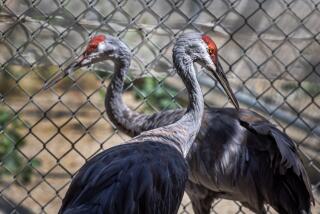Tortoises Adapting to New Habitat : Nature: A three-year study has tracked relocated desert reptiles. The results will help scientists preparing a recovery plan for the imperiled species.
- Share via
KRAMER JUNCTION, Calif. — The air was cool, the sun had scarcely made its morning debut and desert tortoise No. 14 was in a semi-doze. Then along came a pack of humans with science on their minds.
Tap, tap, tap. One of the humans knocked gently on the reptile’s shell.
“C’mon out girl,” the intruder cooed cheerfully. “Let’s go kid.”
Wedged snugly beneath the roots of a creosote bush, the female tortoise showed little interest in going anywhere. So, after a bit more fruitless coaxing, she was plucked from her burrow and placed on a card table set up nearby.
There, the hapless tortoise blinked and flapped a footclaw. Soon, she rested docilely as her captors took weights and measurements and checked her legs for ticks.
The episode, which unfolded Tuesday on a patch of Mojave Desert just north of Kramer Junction, was part of a study designed to document how well the lumbering desert tortoise weathers relocation to new habitat.
Findings from the study, believed to be the most extensive of its kind, could prove useful to federal scientists preparing a recovery plan for the imperiled tortoise, which was added to the nation’s list of threatened species in March.
The effort began three years ago, when the Luz Engineering Corp. announced plans to build a solar power plant alongside U.S. 395 near Kramer Junction. As a condition of the permit issued for the project, the California Energy Commission required that Luz relocate 30 tortoises living on the plant site--and monitor their behavior.
Company officials turned that job over to scientists from Cal Poly Pomona. After assigning each tortoise a number--painted in black letters on top of its shell--and outfitting 20 of them with tiny radio transmitters, the researchers released their subjects on a square-mile desert preserve up the road from the plant site. A control group of 10 tortoises already living in the fenced preserve also were numbered and equipped with transmitters.
Since then, the scientists have been tracking the reptiles’ movements and condition to determine how they are faring in their new home. A final analysis of the data has yet to be made, but some facts are known:
Three of the transplanted animals died of unknown causes.
Two more were victims of poachers, who may have taken them home as pets or made a meal of them.
One animal was stricken with upper respiratory disease syndrome, a mysterious ailment that is decimating desert tortoise populations throughout the West.
Most of the transplanted animals were content to stay put; only three made a stab at getting back to their former home.
Despite the fatalities, Glenn Stewart, a zoologist and the study’s supervisor, said the relocated tortoises appeared to fare as well as the resident tortoises.
“They seemed to adjust to their new surroundings with little difficulty,” Stewart said. “We’ve documented a steady weight loss because of the drought, but the decline has been the same for the relocated and the resident tortoises.”
While other experts said Cal Poly’s findings will shed important light on a little-studied topic, most were cautious in assessing the study’s impact.
“It’s an important question because there will be pressure to relocate tortoises off project sites,” said Larry Foreman, desert district biologist for the U.S. Bureau of Land Management. “But we need more data before we can draw firm conclusions.”
Judy Hohman, a Mojave Desert specialist with the U.S. Fish and Wildlife Service, said one key remaining question about the long-term potential of relocation relates to the respiratory disease.
“Until we know what causes this disease, we don’t want to move tortoises around and run the risk of exposing populations that were previously not infected,” Hohman said.
She added that relocation could ultimately be “a valuable, quick way of re-establishing a tortoise population reduced by predation or other factors.”
Tuesday marked one of the researchers’ final forays into the Mojave. With the study winding down, it is time to take a final look at the reptiles and remove the one-inch-long transmitters glued to their shells.
After weighing and measuring tortoise No. 9, Stewart and graduate student Marianne Marshall used a radio antenna and receiver to guide them to their next target--a male tortoise, No. 14, dubbed Burt Reynolds.
While No. 9 looked healthy, Burt--a resident tortoise approximately 75 years old--was in bad shape, malnourished and thirsty because of scarce rainfall and, consequently, a shortage of the tender annual grasses on which the reptiles feed.
“He looks terrible,” lamented Marshall, pointing out the footlong tortoise’s sunken green eyes. “He’s emaciated and terribly dehydrated.”
Without a good rain, the researchers said sadly as they watched the tortoise scurry back into his sandy burrow, Burt might not make it to winter.






